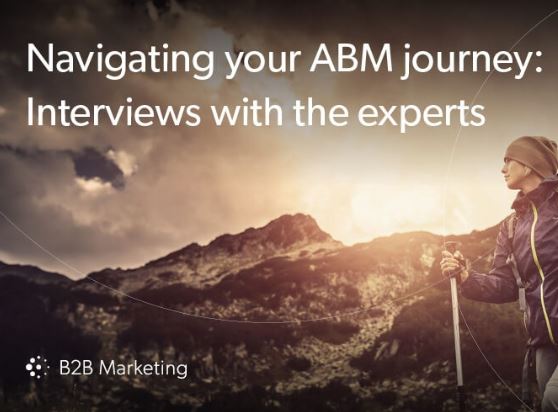Navigating your account-based marketing journey: Interviews with the experts
Robert Norum, ABM practice lead at McDonald Butler: Bev Burgess, Senior VP at ITSMA: Michael Avis Senior director of ABM Oracle: Jessica Fewless, VP ABM strategy at Demandbase
How do you ensure you’re covering every issue when pioneering your ABM journey? We sit down with four ABM experts for their take on achieving account-based marketing success
The basics of account-based marketing
Robert Norum. ABM practice lead at McDonald Butler
Robert Norum is in his element when discussing the growth of ABM.
“You could call ABM the emperor’s new clothes — if you’re really feeling cynical. But ABM has turned something that was intuitive into a more structured process,” Robert explains. “It’s taking best practice to another level, particularly in the context of personalisation.”
Over the last five years, Robert has seen engagement in ABM develop from a few small companies reaping the benefits, to a large number cottoned on and eager to tap into a lucrative ROI driver.
“I think aligning sales and marketing is the key and it’s given marketing a better seat at the table,” he argues.
“Often marketers are seen as internal support units, particularly for the sales team. ABM puts the marketing team centre-stage. Marketers can conduct brilliant research for sales, understand the market, companies and stakeholders, plus facilitate better efficiency in the sales team.”
A common point at which people decide ABM is just good marketing is when it’s rolled out en masse, something Robert calls ‘ABM convergence’.
“This enables companies to move from a one-to-one approach to looking at a particular sector, marketing to numerous accounts at any one time.
Therefore, there’s an overlap between ABM and what some might call industry marketing, which gives you scale but still maintains the process of managing specific accounts,” he explains.
The beauty, of course, is that it holds the best of both – that’s what makes ABM so valuable. “The most compelling part of channels and alliances is doing ABM with your key partners so you’re sharing best practice, confidence, and most likely the cost of the programme,” he says.
Robert’s three steps for optimising ROI through ABM
- Select the right accounts and set a clear agenda. Understand what the organisation wants to achieve and how they plan to do it.
- Research key accounts. Conduct significant research into accounts to determine their sector and stakeholders. Understand as much as possible about the organisation before you talk to them.
- Create a relevant and personalised story. Pitching a strong, clear and personalised story will improve the chances of it getting in front of the right people.
Choosing the right type of ABM for you
Bev Burgess. Senior VP, ITSMA
Having pioneered ABM in the early noughties at ITSMA, Bev Burgess has already experienced the hurdles that ABMers face as their strategic journey develops.
“The best ABM programmes start by ensuring everyone really knows what ABM is, why you’re investing in it and how it works,” says Bev.
“It’s essential to take the time to cut through the confusion and hype. Everyone must understand how the ABM process will deliver growth and support the objectives of your top accounts.”
If you want to surpass the basics, marketing leaders need to build a hybrid ABM approach to complement their company’s traits.
“This means using more than one type of ABM; perhaps there’s a place for all three (strategic, lite, programmatic) as marketing considers investments in different tiers of accounts to complement the investments being made by sales and business leaders.”
After choosing the type(s) of ABM that’s right for you, it’s imperative leaders maintain constant focus on aligning marketing initiatives with account and overall sales and management processes.
Bev warns ABM is a new initiative for most, so after the early excitement, you should expect hard work in maintaining collaboration.
“To ensure the full benefits of ABM, it’s essential to design and run integrated programmes and campaigns across marketing and sales.
And, if you want to accelerate the growth and maximise the lifetime value of each account, which no doubt you do, it’s important to increasingly connect with delivery and customer success programmes,” she explains.
Which type of ABM is right for you?
Strategic ABM is most appropriate for companies that sell high-consideration, complex solutions. Moreover, it is best suited for top-tier accounts – those so important they can make or break the future of the business.
Strategic ABM only makes sense in accounts with large budgets because it’s so resource intensive.
ABM Lite is a good choice for companies that sell high-consideration, high-value solutions under two scenarios: Targeted accounts that are large and strategic, but the organisation is unable to support the account teams on a one-to-one basis.
Or, targeted accounts that are characterised as second tier, and while significant, don’t warrant the same investment.
Programmatic ABM is often reserved for accounts that don’t yet warrant the individual investment of the other two types, and within companies with high-consideration, complex solutions.
In companies with lower-value sales that still want to adopt ABM principles to improve their campaign effectiveness, programmatic ABM is usually the only form of ABM in practice.
How to scale your ABM
Michael Avis. Senior director of ABM at Oracle
As one of the few to boast of a six-year-old ABM strategy, it’s fair to say Michael Avis’ journey is more advanced than most, but he isn’t across the finish line yet.
He’s witnessed how ABM has strategically separated his company from rivals by forming better client relationships.
“It’s helping us show empathy and understanding of clients’ markets, plus the opportunities and challenges they face,” he shares.
“It’s allowed us to be focused on them, not us. We can shift the perception they may have of a company like Oracle from being a technology company provider to a transformational partner.”
The senior director admits Oracle is not tech-heavy in its approach. “We operate in a very personal way, the team engage with sales, talking to customers to create a marketing strategy that works for the particular client they’re focused on.”
The expansion to a programmatic approach has triggered Michael to reassess metrics.
“One thing you need to think about is that traditional marketing measurements and metrics may not be as helpful in this area. Until now, our measurement has been anecdotal, we can see what good looks like, we can feel the enthusiasm our sales teams and clients have for the marketing programmes we’ve executed.
But we need something that’s more structured to demonstrate effectiveness. So ABM needs consideration all the way from readiness to activity, outcomes and business impact.”
Extending your ABM base is no mean feat and you need to be equipped with a plan to overcome the challenges.
Michael advises: “If you’re going to move from 100 to 1000 accounts, you need to introduce a means of scaling.
The basic principles of ABM still need to apply so you can retain the benefit, which is appearing relevant to specific customers. Then, by using technology to see who’s in the market, you can match trends to personas.”
Michael’s advice to those scaling ABM
- Identify success and value. Go after relatively small numbers and build from there. If you’re dealing with 100 accounts look at the top 10, understand and learn from them, then replicate the success.
- Prioritise accounts. Combining data that shows intent and propensity, you can rank which customers are most interested. So, if you have data showing a customer’s strong propensity to buy and your sales force agree, you’re in business.
- Build strong relationships. If you see intent, the sales team also sees potential and you have the basis for a fantastic relationship. Combined, those things are powerful and should be focused on, particularly in strategic ABM.
AI: The future of ABM
Jessica Fewless. VP ABM strategy at Demandbase
Jessica Fewless sees the potential relationship between AI and ABM going far beyond meaningless troves of flashy online adverts.
“AI is quickly becoming a ‘must-have’ technology for B2B marketers. For now, it’s a competitive advantage, but increasingly, more technology and tools will leverage it. If you’re unprepared, you’ll fall behind your peers,” Jessica warns.
“The knowledge that AI can bring to the buying process is by far the most revealing and actionable of any technology to date.”
For example, AI gives companies a newfound ability to know a potential client’s position in the buying journey. Most predictive technologies leverage ‘known’ signals for their algorithms. It’s a step in the right direction, but having access to unknown signals – say a prospect visiting a competitor’s website – gives you an edge.
Demandbase’s VP of product Dom Lindars believes that in five years’ time all vendors will have AI at their core, revolutionising not just their business model but that of their customers’.
Last year, Demandbase acquired Spiderbook, which through AI, can determine the identity and company of seemingly anonymous visitors to their client’s website. This uncovers qualified opportunities and the most relevant buyers within target accounts.
Sales teams can then choose information to populate personalised emails, and the technology can instantly personalise the website to the user, both in terms of how it looks and its navigation.

